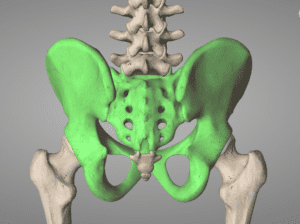What is SI Joint Pain and dysfunction? Can it really be the cause of all of your back, hip, knee and even pelvic floor discomfort?
Essential Anatomy 5.0.5
SI Joint pain and dysfunction may easily be one of the most under-diagnosed and poorly treated physical ailments. The reason for this is that it’s not always JUST pain that you get in the SI Joint. It often manifests as hip, low back, knee or groin pain, sciatica, and even pelvic floor pain. Often, treatment focuses on wherever the pain may be, instead of fixing the SIJ dysfunction. So over the years issues “move around,” or the pain keeps coming back.
This leads patients and practitioners alike throwing up their hands in confusion after they’re exhausted from chasing the pain. If you’re someone who’s had multiple issues in the any of the above areas, chances are that you have SI Joint dysfunction. If you’ve had treatment for pain in any of these areas and it keeps coming back, it’s likely the treatment strategy was incomplete.
Have you already tried massage, chiropractic, injections, exercises, or meds, with little to no lasting results? The good news is you already know what doesn’t work.
Why Haven’t These Things Worked?
To put it simply, most treatments for SI Joint pain and dysfunction only consider one piece of the puzzle. It’s kind of like baking a cake with only flour and milk, you’re missing a lot of key ingredients! Massage will get your muscle tension to go down for a while, but it will come back. Chiropractic will give you some relief from your compressed joints, but your muscles will still be programmed to return you to the same issue. You might have heard of prolotherapy which can help with stability, but cannot fix your movements. Various pain medication is just a temporary bandaid and affects your daily life and mental clarity.
The reason these things don’t work is that they’ve failed to consider the entire movement system. By the entire system I mean the brain, muscles, nerves, ligament stability, and movement. All of these components have to be addressed to resolve SI Joint pain and dysfunction. If you miss one, the body will simply return to how it has been doing things and you’ll be back in pain. Treatments that used to last for months or weeks, will last just days or hours. When you address the entire movement system, people start to get lasting, and oftentimes permanent relief. If you’re curious to read more on this approach, head over to our 5-step treatment process.
How Can Working With An Expert Help SI Joint Pain?
To fix SIJ pain and discomfort requires a strategy, not a protocol. A strategy is flexible and can adapt to each patient depending on their own patterns of dysfunction. There are 45 muscles that attach to your pelvis. A dysfunction in your SIJ leads any number of these muscles to over-act or under-act. This leads to new patterns between the brain and your muscles and joints. It takes an expert to know how to get the under-active ones to be more active before the over-active ones will calm down.
Once balance is achieved, the expert’s role is to guide you through a strength and movement strategy that will assist with stabilizing your body. Because everyone is different, there’s no way to have one protocol to resolve this issue. The underlying strategy is critical to understand, and that is what allows us to adapt the treatment process to the individual’s presentation. Like I mentioned before, SI Joint pain and dysfunction can have detrimental effects on the legs, hips, back, and even the pelvic floor. Due to the fact that each region of the body depends on the next (regional interdependence), SI Joint dysfunction can even contribute to pain in your ankles, feet, shoulders, and neck.
The question you must ask yourself is this. Am I more likely to have multiple issues? Or do I have one central issue that is causing a lot of other little issues?
If you’re ready to work with an expert, click the button below to see if we have availability to start working with you.






